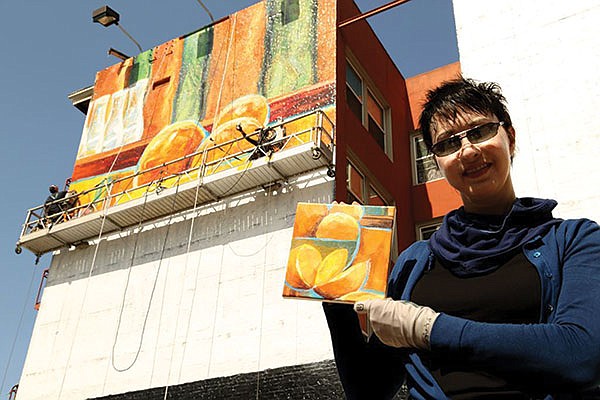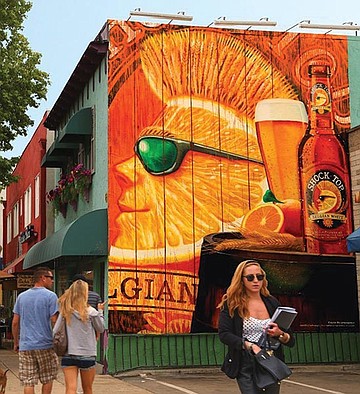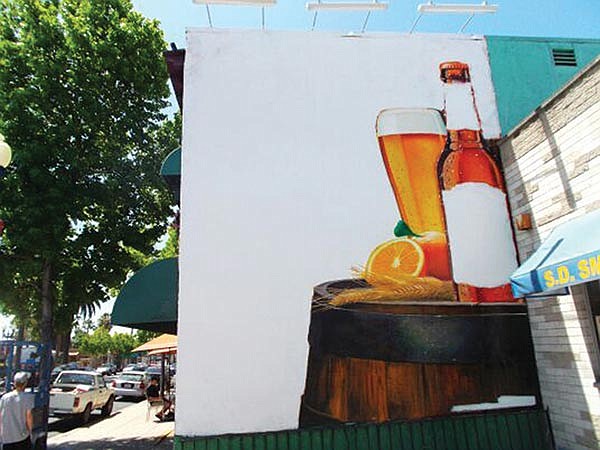 Facebook
Facebook
 X
X
 Instagram
Instagram
 TikTok
TikTok
 Youtube
Youtube

In December 2013, Pam Anderson, founder and owner of the now-defunct ArchitectureArt, a company that specialized in large hand-painted murals, filed a lawsuit against the City of San Diego for violating her right to free speech by prohibiting her from painting large-scale murals on the sides of buildings while simultaneously allowing movie and television studios to drape building-sized banners during Comic-Con without obtaining any permits.

Anderson’s complaints don’t end there. She claims that despite having the appropriate permits, attorneys in the City’s code enforcement unit unfairly revoked permits, later issuing citations and ordering her to destroy murals.
Emails obtained in a public records request support those assertions. The communications also reveal substantial confusion by city staffers regarding the City’s sign ordinance and whether it applied to hand-painted murals.
Anderson formed her company in 2010, to “create a haven for artists to make their living, while preserving an endangered art form dating to the Renaissance,” she explains. “I chose to make San Diego our home given its reputation as a cradle of American outdoor mural art. When first entering the city, one is immediately struck by the abundance of murals of all types adorning private and public buildings, utility boxes, and fences. This is not the case with most cities. Not only does the City enable the propagation of such art by its choice not to regulate murals, the City itself plays a major role in funding and subsidizing a myriad of murals within its borders. Anyone can grab a paintbrush and, with the property owner’s permission, begin painting away — and, indeed, a drive through San Diego reveals just that. The City’s total lack of regulation of murals has resulted in a city-wide patchwork of murals ranging from garish graffiti ‘artwork,’ to religious imagery, to entire buildings painted in multicolored designs.”
But the cradle of mural art has been rocked. Its future may depend on the result of a lawsuit filed by Anderson on behalf of her company.
Though the City has been hands-off with regard to murals, its sign ordinance is one of the toughest in the country. It has been credited for limiting blight by reducing the number of billboards. But less outdoor advertising space prompted advertisers to seek new ways to get their message out. One way has been to use the sides of buildings as blank canvasses for commercial promotion.
Anderson’s ArchitectureArt did both commercial and non-commercial art. And because their commercial efforts were hand-painted murals, Anderson and her attorneys believed they were within the law, specifically the section in San Diego’s Municipal code that states: “painted graphics that are murals, mosaics, or any type of graphic art that are painted on a wall or fence and do not contain copy, advertising symbols, lettering, trademarks, or other references to the premises, products, or services that are provided on the premises where the graphics are located or any other premises are not signs for the purposes of these regulations.”
“I made a number of formal inquiries to the City to understand San Diego’s legal requirements related to mural creation,” wrote Anderson in an email. “Without exception, every single department and city official queried told me that hand-painted murals require no permit. We invested considerable time and funds into establishing our company in San Diego.”

But before the paint could dry on one of her first murals, one depicting a Blue Moon Brewing Company beer outside the Bootlegger Bar in East Village, development services department reversed course, telling Anderson she needed to obtain permits. She did. Then city staffers went a step further and ordered the mural destroyed. The spat was covered in a June 13, 2013 article in CityBeat.

“Shortly after starting work here, the City began issuing citations, defying the very advice they had given us,” added Anderson. “Not only did the citations contradict the City’s own actions and advice, they seemed to be acting in a punitive manner, citing us for violations that simply did not exist. In each case, I would respond to the City with detailed documentation as to why the citation was incorrect. But rather than responding to me, they would simply demand fees or threaten further penalties.”
The fight over murals continued for more than two years. Still believing a compromise could be reached, she continued to seek a resolution with development services and obtain the necessary permits.
A resolution was reached in May 2013 when development services staffer, Michael Richmond, issued Anderson two permits to paint murals, one in Downtown and the other in Pacific Beach. Thinking the kinks were worked out, she gathered her team of artists to begin work.
Just over a week later, deputy city attorney for the code enforcement unit Jon Dwyer once again offered a new interpretation, pulling the permit, and threatening to levy fines on ArchitectureArt.
“Your client,” Dwyer emailed Anderson’s attorney James Azadian, “is free to act in any way she deems fit, however, she will be subject to further enforcement action from my unit if the manner in which she acts is illegal. Please remember the Code Enforcement Section and my unit are not subject to Ms. Anderson’s business timelines,” wrote Dwyer in a May 20, 2013 email.
The deputy city attorney went one step further in a follow-up email, at one point acknowledging the possibility of future litigation. “It sounds like your client made an effort to achieve voluntary compliance for this particular mural. It seems like you will have an estoppel argument if we have to litigate the issue based on the permit your client obtained, however, as we discussed in our meeting, this particular sign would have to be completely painted over and could not be appropriately permitted by the City. The fact that your client obtained a permit through a mistake of a City department or employee does not remedy that issue. I in no way indicated that a permit obtained contrary to the [San Diego Municipal Code] requirements would equate to compliance.”
That was the last straw for Anderson. Tired of trying to hit what seemed to be a moving target, she packed up her shop and closed for good.
But it won’t be the last time that the City will need to address the issue. As predicted by deputy city attorney Dwyer, Anderson filed a lawsuit. She claimed that she was unfairly targeted and discriminated against while at the same time other entities more profitable to San Diego, such as those involved in Comic Con, have a blank canvas on which to work. She cites the oversized banners hung from buildings around the city during the convention.
“I’ve tried to understand the City’s response and remember asking if those involved in Comic Con are held to the same standards as me. A Development Services supervisor told me that the City doesn’t regulate the Comic Con off-site signage. To this day, I do not understand how that can be.”
The issue over murals is far from over. And it appears as if the City will be forced to touch up its current sign ordinance. In June 2013, in a similar lawsuit filed over the Agua Caliente Racetrack mural on the side of the California Theatre, a judge ruled that it was illegal to revoke already-issued permits unless the permitted work is not performed or if the permit’s terms are not observed.
Council president Todd Gloria’s office would not respond citing the current litigation.


In December 2013, Pam Anderson, founder and owner of the now-defunct ArchitectureArt, a company that specialized in large hand-painted murals, filed a lawsuit against the City of San Diego for violating her right to free speech by prohibiting her from painting large-scale murals on the sides of buildings while simultaneously allowing movie and television studios to drape building-sized banners during Comic-Con without obtaining any permits.

Anderson’s complaints don’t end there. She claims that despite having the appropriate permits, attorneys in the City’s code enforcement unit unfairly revoked permits, later issuing citations and ordering her to destroy murals.
Emails obtained in a public records request support those assertions. The communications also reveal substantial confusion by city staffers regarding the City’s sign ordinance and whether it applied to hand-painted murals.
Anderson formed her company in 2010, to “create a haven for artists to make their living, while preserving an endangered art form dating to the Renaissance,” she explains. “I chose to make San Diego our home given its reputation as a cradle of American outdoor mural art. When first entering the city, one is immediately struck by the abundance of murals of all types adorning private and public buildings, utility boxes, and fences. This is not the case with most cities. Not only does the City enable the propagation of such art by its choice not to regulate murals, the City itself plays a major role in funding and subsidizing a myriad of murals within its borders. Anyone can grab a paintbrush and, with the property owner’s permission, begin painting away — and, indeed, a drive through San Diego reveals just that. The City’s total lack of regulation of murals has resulted in a city-wide patchwork of murals ranging from garish graffiti ‘artwork,’ to religious imagery, to entire buildings painted in multicolored designs.”
But the cradle of mural art has been rocked. Its future may depend on the result of a lawsuit filed by Anderson on behalf of her company.
Though the City has been hands-off with regard to murals, its sign ordinance is one of the toughest in the country. It has been credited for limiting blight by reducing the number of billboards. But less outdoor advertising space prompted advertisers to seek new ways to get their message out. One way has been to use the sides of buildings as blank canvasses for commercial promotion.
Anderson’s ArchitectureArt did both commercial and non-commercial art. And because their commercial efforts were hand-painted murals, Anderson and her attorneys believed they were within the law, specifically the section in San Diego’s Municipal code that states: “painted graphics that are murals, mosaics, or any type of graphic art that are painted on a wall or fence and do not contain copy, advertising symbols, lettering, trademarks, or other references to the premises, products, or services that are provided on the premises where the graphics are located or any other premises are not signs for the purposes of these regulations.”
“I made a number of formal inquiries to the City to understand San Diego’s legal requirements related to mural creation,” wrote Anderson in an email. “Without exception, every single department and city official queried told me that hand-painted murals require no permit. We invested considerable time and funds into establishing our company in San Diego.”

But before the paint could dry on one of her first murals, one depicting a Blue Moon Brewing Company beer outside the Bootlegger Bar in East Village, development services department reversed course, telling Anderson she needed to obtain permits. She did. Then city staffers went a step further and ordered the mural destroyed. The spat was covered in a June 13, 2013 article in CityBeat.

“Shortly after starting work here, the City began issuing citations, defying the very advice they had given us,” added Anderson. “Not only did the citations contradict the City’s own actions and advice, they seemed to be acting in a punitive manner, citing us for violations that simply did not exist. In each case, I would respond to the City with detailed documentation as to why the citation was incorrect. But rather than responding to me, they would simply demand fees or threaten further penalties.”
The fight over murals continued for more than two years. Still believing a compromise could be reached, she continued to seek a resolution with development services and obtain the necessary permits.
A resolution was reached in May 2013 when development services staffer, Michael Richmond, issued Anderson two permits to paint murals, one in Downtown and the other in Pacific Beach. Thinking the kinks were worked out, she gathered her team of artists to begin work.
Just over a week later, deputy city attorney for the code enforcement unit Jon Dwyer once again offered a new interpretation, pulling the permit, and threatening to levy fines on ArchitectureArt.
“Your client,” Dwyer emailed Anderson’s attorney James Azadian, “is free to act in any way she deems fit, however, she will be subject to further enforcement action from my unit if the manner in which she acts is illegal. Please remember the Code Enforcement Section and my unit are not subject to Ms. Anderson’s business timelines,” wrote Dwyer in a May 20, 2013 email.
The deputy city attorney went one step further in a follow-up email, at one point acknowledging the possibility of future litigation. “It sounds like your client made an effort to achieve voluntary compliance for this particular mural. It seems like you will have an estoppel argument if we have to litigate the issue based on the permit your client obtained, however, as we discussed in our meeting, this particular sign would have to be completely painted over and could not be appropriately permitted by the City. The fact that your client obtained a permit through a mistake of a City department or employee does not remedy that issue. I in no way indicated that a permit obtained contrary to the [San Diego Municipal Code] requirements would equate to compliance.”
That was the last straw for Anderson. Tired of trying to hit what seemed to be a moving target, she packed up her shop and closed for good.
But it won’t be the last time that the City will need to address the issue. As predicted by deputy city attorney Dwyer, Anderson filed a lawsuit. She claimed that she was unfairly targeted and discriminated against while at the same time other entities more profitable to San Diego, such as those involved in Comic Con, have a blank canvas on which to work. She cites the oversized banners hung from buildings around the city during the convention.
“I’ve tried to understand the City’s response and remember asking if those involved in Comic Con are held to the same standards as me. A Development Services supervisor told me that the City doesn’t regulate the Comic Con off-site signage. To this day, I do not understand how that can be.”
The issue over murals is far from over. And it appears as if the City will be forced to touch up its current sign ordinance. In June 2013, in a similar lawsuit filed over the Agua Caliente Racetrack mural on the side of the California Theatre, a judge ruled that it was illegal to revoke already-issued permits unless the permitted work is not performed or if the permit’s terms are not observed.
Council president Todd Gloria’s office would not respond citing the current litigation.
Comments